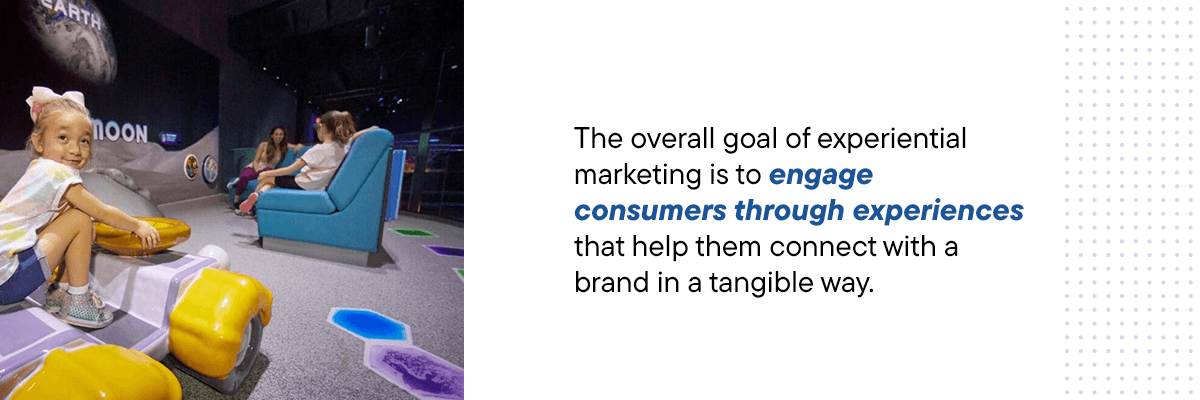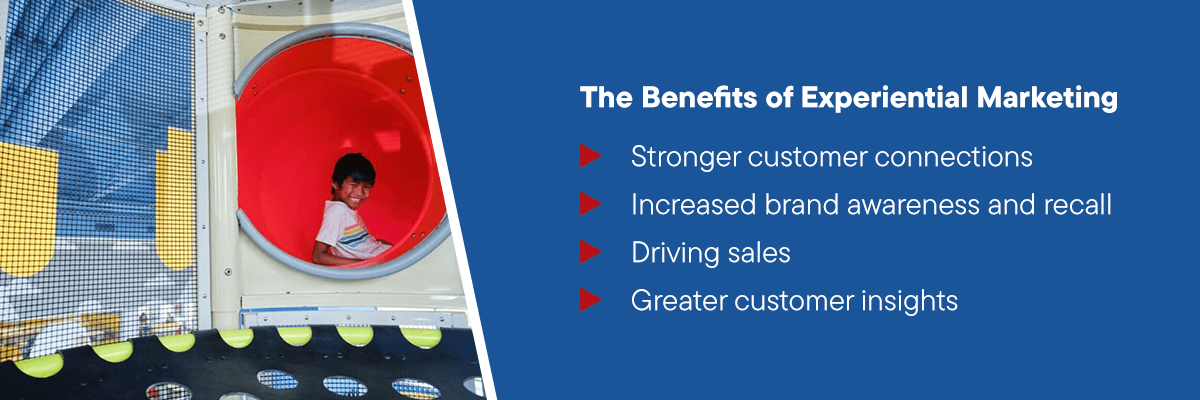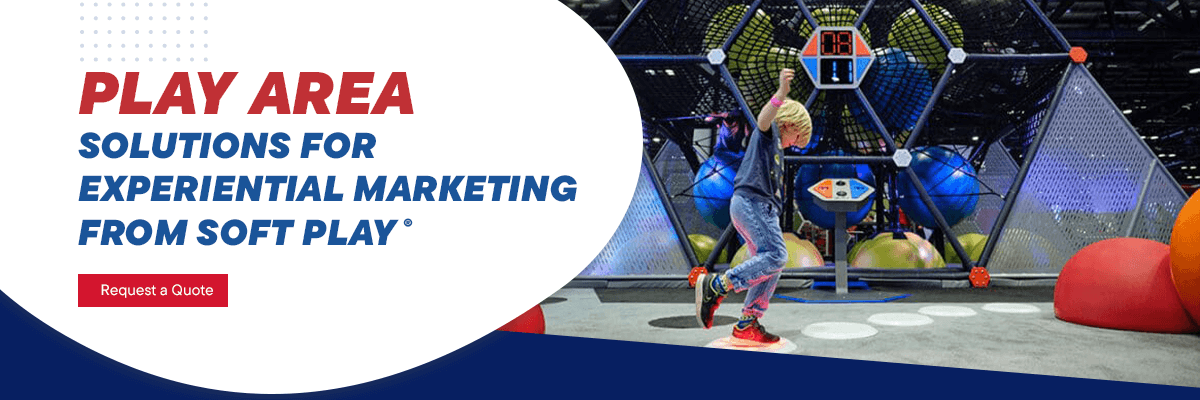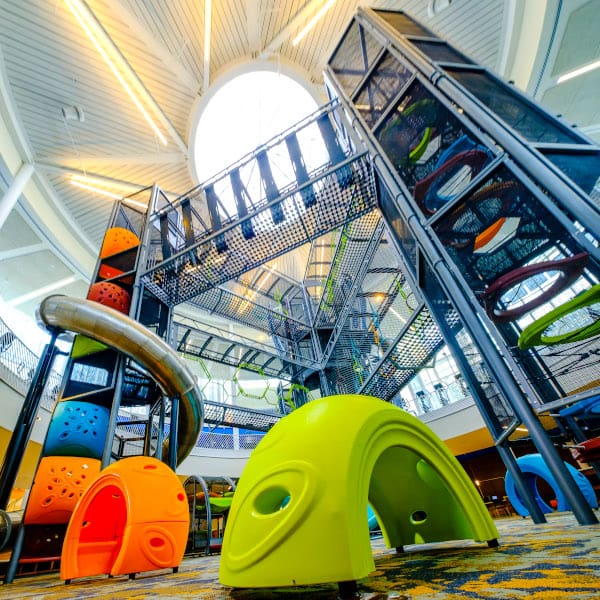What Is Experiential Marketing?

What Is Experiential Marketing?
In a digital world, people crave real-life experiences more than ever before. By fulfilling this simple but innate desire, your business can engage existing and potential customers and build the connection between them and your brand.
Experiential marketing, also called event or engagement marketing, encapsulates this concept and creates ways for customers to engage and experience your brand firsthand. Using playgrounds as a marketing vehicle is an excellent example of experiential marketing.
Understanding Experiential Marketing
Experiential marketing strategies focus on creating memorable brand experiences. The overall goal of experiential marketing is to engage consumers through experiences that help them connect with a brand in a tangible way.

An excellent way to further understand what experiential marketing is is to compare it with traditional marketing. Key differences between experiential and traditional marketing include:
- Emphasis on features versus experiences: Traditional marketing tends to emphasize the product itself. Traditional marketing mainly highlights product features as a competitive edge. Experiential marketing naturally emphasizes the customer’s holistic experience while using the product or interacting with the brand.
- Views on customer behaviors: Traditional marketing assumes customers are more rational than emotional and appeals to this perceived rationality by promoting the brand and product’s functionality. Experiential marketing assumes customers are rational and emotional, which brands can appeal to with immersive and memorable experiences.
- Using media versus engagement: Traditional marketing uses various forms of media to promote products and brands, from print to radio and television. Experiential marketing uses events and experiences as a marketing platform.
Elements of Successful Experiential Marketing
Consider these core elements of how experiential marketing works:
- Make the experience immersive: To make the experience as immersive as possible, you can create a series of varied strategies. Consider interactive tours, themed experiences and similar ideas.
- Form an emotional connection with customers: One way experiential marketing stands out from traditional strategies is by making it much easier to form an emotional connection with your customers. Traditional strategies are excellent for highlighting a product’s features, but they’re not necessarily effective at being personalized and memorable. When the experiences you create match your customers’ values and help fulfill their interests and desires, you leave a positive and lasting impression.
- Have elements of storytelling: Meaningful storytelling is an essential part of traditional marketing, and it lends itself well to experiential marketing, too. Even better, with experiential marketing, your customers get to be an active part of your brand’s stories, which is a powerful way to connect customers to your brand and products. The best storytelling elements are authentic to your brand and resonate with your customers.
- Prioritize customer participation and engagement: Customers need to engage for experiential marketing to be effective. The core difference between traditional and experiential marketing techniques is that the latter is far more passive — even when it’s successful. It’s important to note that some strategies may look experiential on the surface but can fall short of being an experience your customers are actually immersed in. For example, hosting an event may seem experiential, but this strategy may need rethinking if customers are passively watching a product demo and nothing more.
- Lend from tried and tested methods: Traditional and experiential marketing each have unique and effective strategies, so incorporating traditional marketing techniques can be beneficial. Traditional techniques you can explore include making your events social media-friendly, having exclusive or customizable events for top clients, and promoting your event through your most successful traditional channels.
How to Prepare for Experiential Marketing
These considerations can help you create a successful experiential strategy:
- Have fun with ideas: Brainstorm the different ways you want to boost brand awareness by involving your customers in an immersive experience. You can be as creative as possible to come up with ideas for memorable experiences as long as they align with your brand and reflect your customer base well.
- Set a clear objective: When brainstorming for your events, have a clear objective that goes beyond simply engaging your audience and promoting your brand. One of the best parts of experiential marketing is that you get to determine how you want your customers to feel and how you want to resonate with them — and you can set objectives around this. Do you want your audience to feel a sense of wonder, curiosity, personal connection or excitement? Your experiential marketing can drive that.
- Do your research: As you would with traditional marketing, conduct enough market research to understand who your core audience is and the type of experiences that would resonate with them most.
- Don’t neglect marketing basics: Promote your events using traditional marketing techniques such as radio, print or social media. These strategies are vital to ensuring a good customer turnout.
- Encourage collaboration: Involve different colleagues throughout the process and encourage collaboration each step of the way. By involving all teams, from public relations to branding and marketing and beyond, you get a range of input to make your approach more comprehensive, immersive and tailored to your audience.
- Avoid making the experience “salesy”: Customers want to attend fun, engaging and memorable events — not experiences that feel like intense sales pitches. If attendees feel like they’re constantly being sold a product or service, they may have negative feelings about your event and share those thoughts with others. While you want to showcase your brand, avoid going overboard.
Top Experiential Marketing Ideas
The world is your playground when it comes to implementing experiential marketing. The great benefit of these ideas is their versatility. Whether you’re a business owner, marketer, manufacturer or other professional, you can adapt most of the following strategies.

Immersive Events
If you have a product or service that appeals to families and children, an immersive play experience can be a unique and fun way to market your brand and standout from competitors. The best part is that there are so many ways for different industries to make connections between immersive play events and products and services.
A kids’ apparel company may include different textiles in its custom play area to elevate the sensory component. A snack company may customize a play area by having components that resemble food. You can even find interactive play attractions for marketing consumer electronics products.
Themed Experiences
A great way to promote your product is through themed experiences that you can tie back to your product.
For example, a company that sells sunscreen may host an event at a water play park and use themed aquatic attractions to drive the marketing message while creating an engaging experience. Consider interactive elements like water slides, water walks, foam floatables and splash pads to create a fun and immersive experience for the whole family. You could even hand out free samples of the product to complement the event.
Themed experiences can work for almost any type of product or service you want to market, and the fun is in getting as creative as possible to tie the theme to your brand for an experience your customers won’t forget.
Interactive Tours
Interactive tours are trending for a reason — they’re unique, immersive and memorable. These tours are slightly different depending on the brand and its products, but they feature some common elements, such as larger-than-life displays that are often interactive and unique activities that allow attendees to create their own personalized products.
Successful interactive tours rely on themed environments with family-friendly games and play spaces. Your themed environments might include various elements like hanging sculptures and outdoor play sculptures.
You can also adapt your experiential tours as needed. If you’d like to engage potential stakeholders, you can have an exclusive tour with added elements like catering or hosting special events that are open to the public to boost brand awareness.
Adventure Experiences
Consider adventure experiences for a thrilling and unforgettable experiential marketing strategy. Elements of adventure, like a unique obstacle course for the whole family, provide the perfect backdrop for fun and meaningful bonding. Because of the exhilarating and positive emotions adventure experiences provide for your audience, they can be the epitome of experiential marketing.
For any experiential event you host, you should always consider the entirety of the experience for your customers. At the core of these events is the touch and feel experience and immersive, action-based activities. That’s why having hands-on entertainment like a good play area with custom branding is such an effective strategy that goes beyond simple signage.
To complete the experiential marketing experience and take your customer engagement to the next level, consider the following:
- Location: Host your live events in a family-friendly and accessible location to draw in larger crowds.
- Displays: In addition to entertainment, include product displays with interactive elements that allow your customers to fully experience your offerings. You can also hold engaging workshop hours that let your audience learn more about you and interact with you personally.
- Refreshments: Have food, snacks and drinks available to cater to your audience.
- Restrooms: Ensure there are clean and accessible facilities.
Permanent Experiential Marketing With Custom Playgrounds
Do you have an establishment you’d like to market, particularly as a family-friendly environment? A playground is a sought-after attraction that sets you apart from competitors. Parents desire a space where they can take a break or catch up with other parents while their kids are happily entertained and engaged with their own friends.
The playground will serve as a permanent feature, and you can elevate how it drives your marketing by including your branding on the playground and sharing photos of the attraction in your social media posts.
The Benefits of Experiential Marketing
Experiential marketing has several standout benefits, from building brand awareness to potentially driving sales.

- Stronger customer connections: Most customers have perceptions of brands, whether positive, neutral or negative. These perceptions are often emotionally rooted. By forming a connection with your customers through experiences you actively share with them, you can enhance your brand and be a fan favorite with a loyal customer base.
- Increased brand awareness and recall: Every company continually strives to increase brand awareness. Engagement marketing is a tool that helps you grow your brand and become a leader in your industry. Successful experiential marketing can help form powerful associations with your customers — when they think of the experience, your brand and product will also come to mind.
- Driving sales: One of the main benefits of any marketing strategy is its potential to drive sales. When you provide your customers with unforgettable experiences, they’re more likely to purchase your products and tell others about your brand. Word-of-mouth, whether personally or through social media, is a powerful sales tool.
- Greater customer insights: Experiential marketing can help your company gain unique customer insights. With traditional marketing, the data you receive through survey forms and similar can often be disconnected from the reality of what customers truly feel and think. In experiential marketing, customers are fully engaged, making them far more transparent and honest in their feedback.
Play Area Solutions for Experiential Marketing From Soft Play®
Engagement marketing is one of the most powerful tools for building brand awareness and establishing a meaningful and long-lasting impression with customers. This strategy is often more effective at fulfilling your customers’ needs, leading to higher engagement and potential sales through word-of-mouth promotions.
If you’re ready to explore experiential marketing strategies, Soft Play can create memorable events and activities with indoor and outdoor play areas, sculptures and themed environments. Our team of professionals designs and creates quality custom play equipment you can use for experiential marketing and branding. Our play spaces are also designed to encourage diversity and inclusivity, so you can reach all your patrons with your experiential marketing strategy.
We provide various indoor, outdoor and aquatic services and products, including ADA-compliant equipment for more accessible spaces. Get started with experiential marketing with reliable custom playgrounds today! Contact us for a free design consultation or request a quote.

